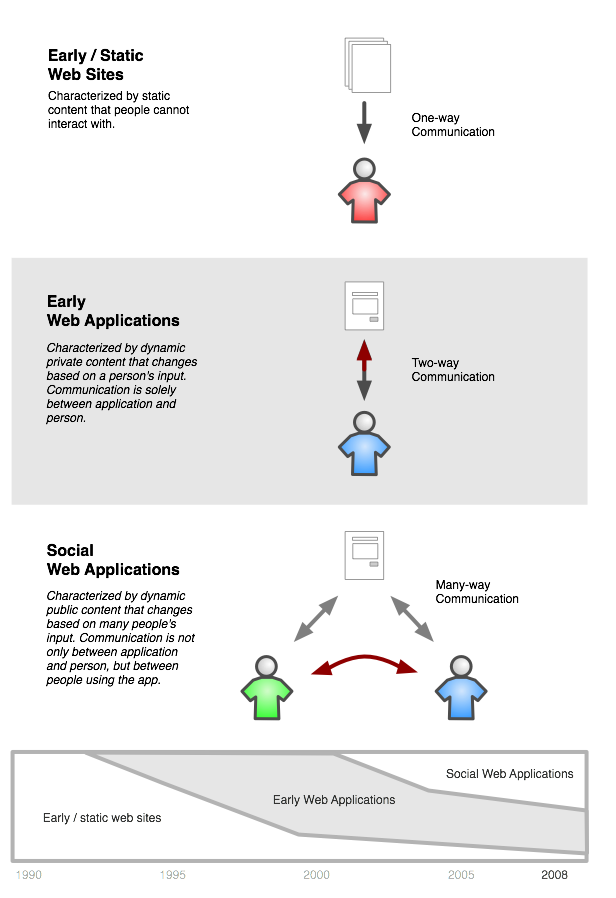A simple illustration of social design
The big shift to social design is that people are now talking to each other through software. (illustrated)
There is a lot of “social” talk these days, whether it’s social media, social marketing, or social design. Frankly, it’s hard to keep track of it all. When I get into a discussion with someone on one of these subjects, I rarely know where it will end up…are we talking about social interaction or something else?
But I’m pretty sure that social design, at least one way of thinking about it, is something relatively new (as in, the last decade or so). To try and illustrate this, it helps to look at how we’ve evolved so far on the web…I think we’ve seen an evolution in three broad steps:

Social design is the design of these social interactions (red bendy arrow on the bottom). It’s enabling people to talk to each other and thereby improving their experience. They may be commenting, recommending, friending, or some other social activity. In short, social web applications enable conversation between people who use a web service, not just between people and the web app itself. For years web sites would simply save your preferences and transactions, and as a user it didn’t matter if anybody else used the web site or not (think banking applications). It was a personal tool, for personal use, much like desktop software. Going from personal use to broader social interaction is the crucial distinction.
The genesis of web-based social applications were the bulletin board systems of the Internet, which pre-dated the web and were around since the 70s. These BBSs, as they were called, declined rapidly with the surge of the Internet in the late 1990s.
However, while bulletin boards were the precursor, they were not people-centric. They were instead topic-centric, meaning that discussions revolved around topic threads. What made some of the early social web applications different (PlanetAll, Friendster) is that they focused on the person as the primary pivot (see Finding the Primary Pivot), meaning that you model relationships between people (friend them). This was another huge step in social web application design.
Blogging, which started in earnest around 2000, was also a big push forward for the idea that getting people talking to each other maight actually be a valuable endeavor. Amazon and eBay were the pioneers here, as they laid social elements on top of business transactions to make those transactions more valuable.
Additionally, much of the current evolution of social software is in improving the communication between people who provide a service and people who use a service. This is what I think is meant by “social media marketing”. This is somewhat of the fourth wave…when social applications not only improve the conversations between people using the site, but between people who provide the site and those who use it. (Tearing down the firewall isn’t easy) While email has done much of the heavy lifting here for many years, the mere act of putting these conversations public changes further interaction around them, while scaring the wits out of executives who worry that negative conversation will bring down their empire. (What they don’t count on are the fans they have who defend them)
So while all of this stuff is constantly evolving, and the word “social” is bandied about in countless ways, social design is relatively concrete: it’s designing software that support social interaction.